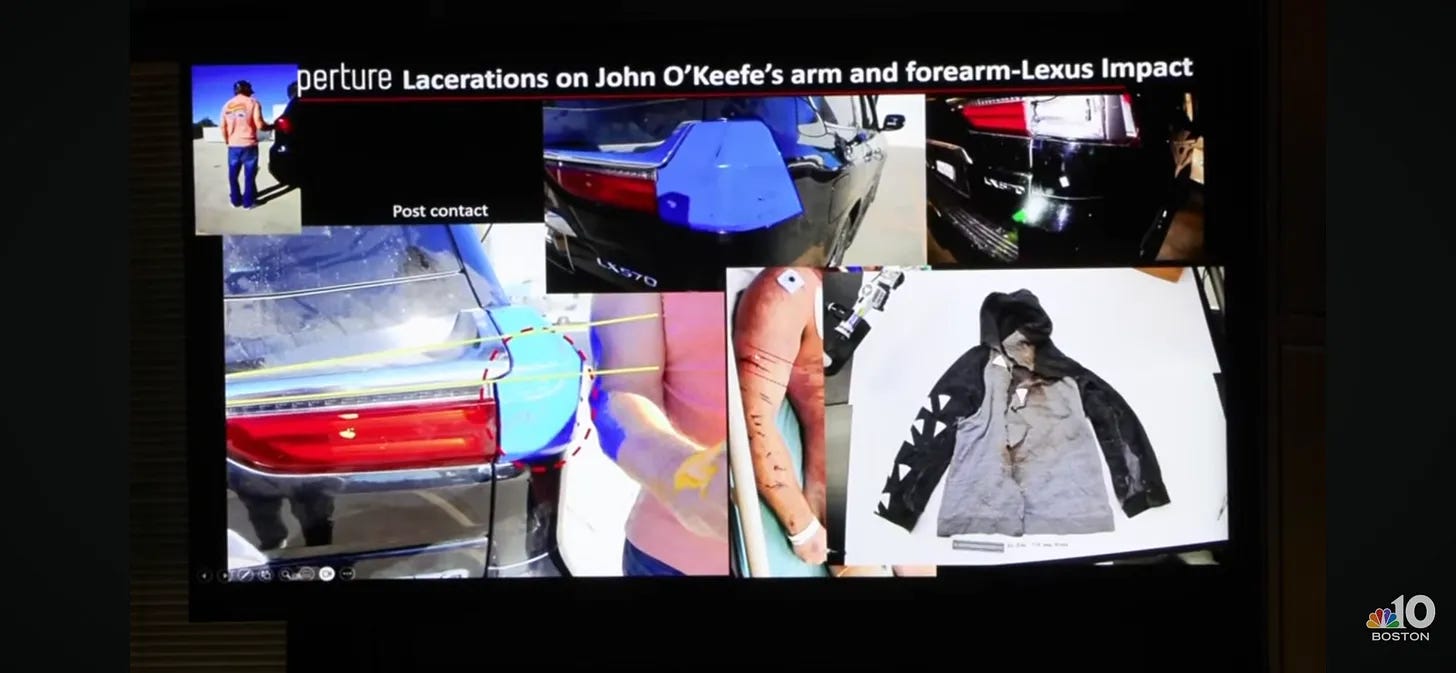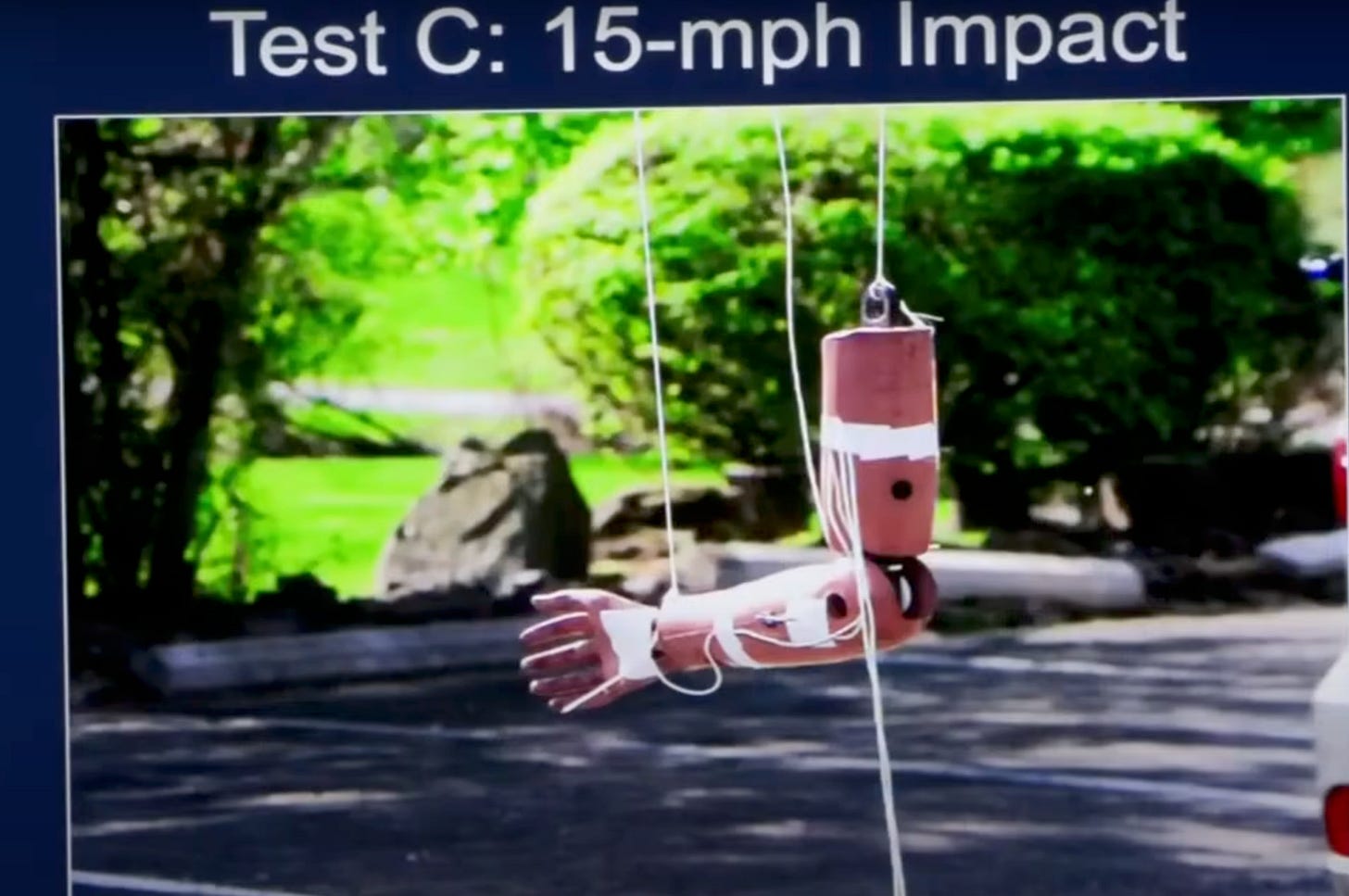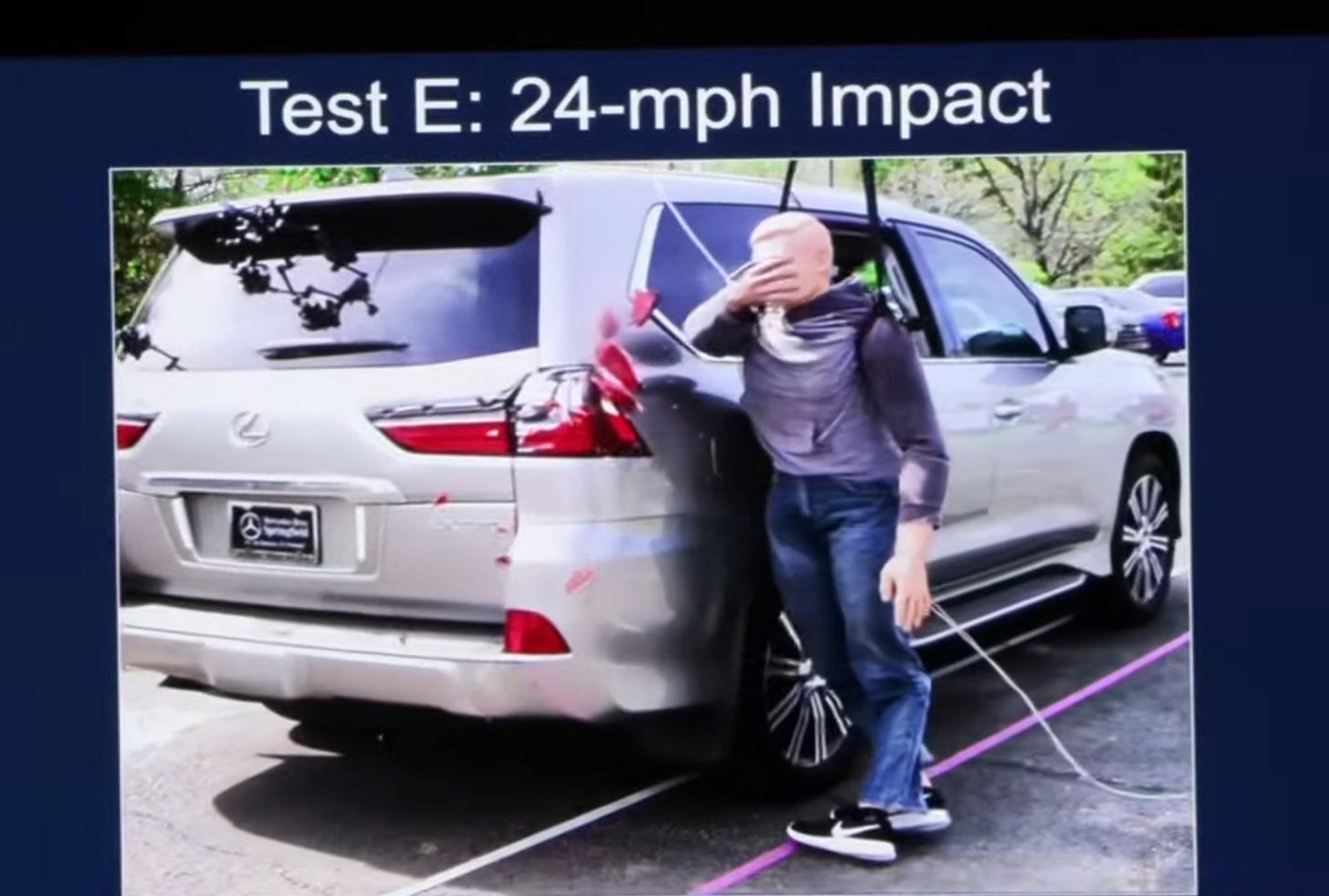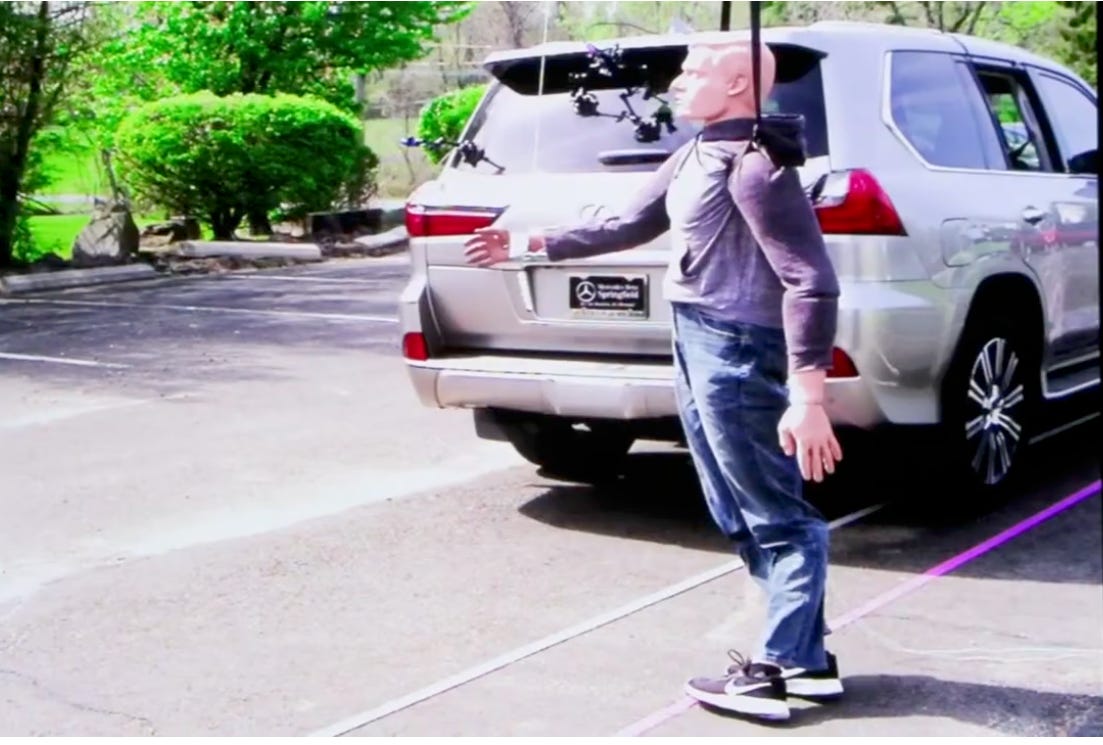DAY 28: Karen Read Retrial
Did Karen's own expert help prove that John WAS hit by her vehicle? 😳😬
Happy Sunday!
This past Friday, the defense team called Daniel Wolfe (Director of Accident Reconstruction for ARCCA) to the stand.
However —
His testings seemed to reinforce the state’s own theory by showing a clear visual of not only what the reverse impact would look like, but that it mimics nearly identical results of all evidence found.
You might need to sit down for this recap.
Daniel Wolfe (Director of Accident Reconstruction for ARCCA)
Wolfe specializes in the fields of Accident Reconstruction, Human Factors, and Lighting.
He became the Director for the Department of Accident Reconstruction in January of 2024. His education and work history can be found here.
As pointed out by the CW, Wolfe has not taken any classes regarding pedestrian strikes. He also failed his first attempt at becoming certified in Accident Reconstruction, which Wolfe dismisses by saying the test was ‘elementary’.
(Opinion: I don’t think it’s a big deal if a person doesn’t pass a test initially, however, Wolfe’s response to being asked about it was odd. By describing the test as simply elementary, he actually made it seem worse that he failed it.)
Origin of ARCCA’s Involvement
To avoid any prejudice, the judge has previously ruled that the jury is not allowed to hear that there was once a federal investigation looking into this case. That investigation came to a close earlier this year with zero indictments indicating that there is no evidence of corruption or conspiring to frame the defendant, Karen Read.
The attorneys are allowed to reference the U.S. Attorney’s Office for Massachusetts as an outside ‘entity’.
In late 2023, ARCCA was contracted by the ‘entity’ to give an opinion on whether the victim’s injuries were consistent with a vehicle-pedestrian accident.
The documents provided to them included: the autopsy report, police reports, and photos of the damaged vehicle. They were given access to view the vehicle in person, but chose not to.
ARCCA was never provided the techstream data report prior to their original testing. This means they made conclusions without knowing the vehicle reverse speed, throttle percentage, and vehicle reverse distance. They were later provided info about shards of tiny taillight fragments lodged in his clothing.
(Note: We learned in a past hearing that the federal investigation was at the request of the defendant’s defense team. The State Attorney at that time, Josh Levy, agreed to pursue it. Since the investigation was looking into the state employees, the documents provided to ARCCA were only requested from the murder defendant’s team. This - arguably - causes a concerning issue with how limited and potentially curated the information provided to ARCAA was for that initial analysis. Josh Levy has never spoken publicly about this, and John O’Keefe’s family has shared their frustration with his lack of communication with them.)
The original testing that Wolfe and several other partners did was boiled down to two main hypotheses they chose to test:
Did John’s cocktail glass break the taillight?
They built a potato-type cannon to shoot the cup at the taillight.
Did Karen Read’s SUV cause John’s head wound from a direct impact?
(The Commonwealth never claimed the vehicle hit John in the head, nor did they claim the cocktail glass was what caused the taillight damage, so the CW shared their frustration with the misguided focus in the first trial.)
After this testing, Wolfe and his 2 partners concluded that John’s injuries were not consistent with a pedestrian accident.
Wolfe Critiques the State’s Expert Testing
On direct, Wolfe dismisses the state’s expert, Welcher’s testing methods. Here is the recap of Welcher’s testimony from a week ago if you missed it.
Wolfe says that Welcher’s “static test” only shows that an arm can align with the taillight. Wolfe says any arm can align with the taillight depending on body position.
(Opinion: Wolfe is claiming that basic height measurements do not matter when discussing whether John’s arm holding a cocktail glass would naturally align with the taillight. Basic measurements seem pretty important when it comes to whether an object was hit in a specific area, so this came across as a red flag for me in regard to bias.)
Wolfe also dismisses Welcher’s “dynamic test” (blue paint transfer test) because it was only done at 2 mph to show where the taillight would hit the arm, and how the arm would continue to maintain contact briefly as the vehicle reversed. Wolfe states this doesn’t present what would happen at faster speeds.
Wolfe Shares His New Testing
Wolfe said he was testing to see if Welcher’s opinions were correct.
Wolfe and his partner performed a series of tests at different speeds of a vehicle hitting an arm.
They were seeking how the arm would impact a taillight, as well as how the taillight would impact the arm.
Some of the tests were done in a lab using a dummy doll and a taillight being projected forward by a machine. Some tests were done outdoors with just a hanging dummy arm suspended in the air from a rope while a vehicle reversed at it. And another one was done with a vehicle reversing at a full dummy doll suspended in a harness.
Test E was done at 24 mph, which is the highest speed reported on the techstream data of Karen’s vehicle when she reversed. We do know that the SUV was still at 74.5% throttle at the end of that trigger event recording, so it’s likely the speed increased even more than that before she stopped reversing.
This test shows how the dummy doll’s arm impacted the taillight and caused the plastic cover to shatter. The comparison of what the damage looks like from the testing to what Karen’s actual taillight damage was is very similar.
Not only did the jury see an actual reenactment of what the CW’s theory looks like, but they witnessed how an arm can cause the type of damage that Karen’s taillight endured. They also saw how the lower portion of a person’s body could go uninjured in this type of accident.
The debris field of how the shards spread all over the place can also be seen in the testing, which again, aligns with the Commonwealth’s own theory presented.
It’s quite baffling that the defense presented this evidence in an attempt to discredit the state’s opinion, when it only strengthened it even more.
So how does Wolfe justify the testing as proof that John was not hit?
He points to a clear diffuser piece of plastic that is inside the taillight housing that remained intact during the impact testing (It cracked, but didn’t shatter at one point). The one on Karen’s vehicle broke off completely.
He also points to the victim’s sweatshirt and says the taillight pieces did not cause any holes/tears in the arm from the impact.
Prosecution Questions Wolfe’s Testing
Wolfe chose a dummy arm that was 9.38 lbs instead of the 12 lb arm option. John’s general arm weight for his height and body mass is about 11.8 lbs.
Instead of using the dummy arm closest in weight (only .2 pounds heavier), Wolfe chose the arm that was 2.42 lbs lighter.
Which means he chose to test the impact with an arm mass that was 20.5% less heavy. He dismisses that this weight difference matters, but then later agrees that weight can change outcomes.
In another testing, he used a dummy doll that was around 23% less heavy. There was also another doll used who was closer to John’s height and weight, however Wolfe said he is unsure how much the arm actually weighed on that doll.
Prosecutor Brennan points out that the differing variables used in the testing were all over the place.
The indoor lab test he performed utilized a machine that projected the taillight housing at the dummy arm, however Wolfe agrees that it doesn’t do a full push through drag motion like a vehicle would in reverse. A full push through would cause the arm to continue having brief contact with it as the SUV moved past it.
Wolfe disagrees at one point that body position can change the impact results, but then later says it does.
A photo is presented of the dummy with holes in the sweatshirt despite being told on direct that the sweatshirt remained intact. Wolfe says the dummy’s sweatshirt received holes from the road rash it endured, not the broken taillight. Prosecutor Brennan asks if a frozen ground could also cause road rash, and Wolfe says he doesn’t know.
Wolfe agrees that a dummy on a harness will not replicate full motion of a body when clipped by a vehicle. He also agrees that the floating arm (suspended by rope) will not replicate what the exact motion a real arm would make after impact.
The dummy test that was harnessed and tethered from a rope showed how the doll’s feet were not planted firmly on the ground because the harness works against the gravity of the dummy’s weight. Thus, removing the amount of weight from the body being hit.
Wolfe says they didn’t add a glass to the dummy’s hand because it wasn’t feasible in the testing process, but holding the cup could potentially have impacted the damage of the vehicle as well.
Potential Bias
Prosecutor Brennan questions Wolfe on the concerning issues that came up in hearings prior to this trial. If you’re unaware of the ARCCA issue (or just need a refresher) that led to the defense being found in violation of the court twice, you can find the first article HERE , and the follow-up one HERE.
Prosecutor Brennan points out that the defense team and Wolfe were requested to provide communications between them, but those communications were deleted by both parties. You can read about this from the voir dire recap (located at the end of the article) that occurred during the first week of this trial.
Wolfe’s wife joined a “Free Karen Read” Facebook group after the first trial ended, and received praise from the fanatical supporters for her husband’s testimony. Wolfe testified in trial that he is unaware of how his wife feels about the case.
The day ended with Wolfe on redirect, and will continue again on Monday.













Wolfe is a creep and I hope his parenting is better than what I think it might be. UGH.